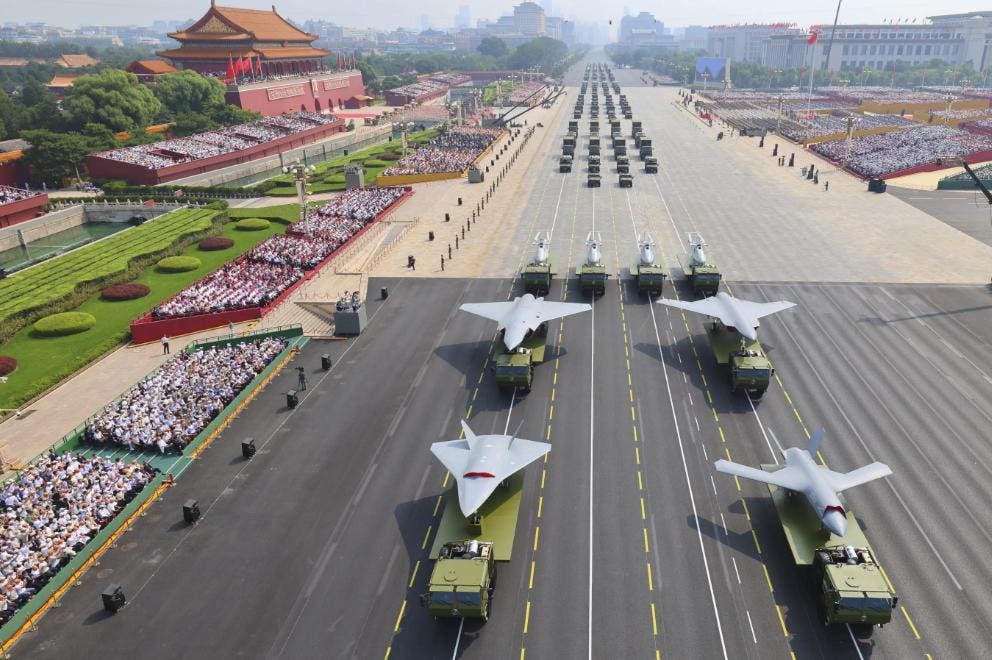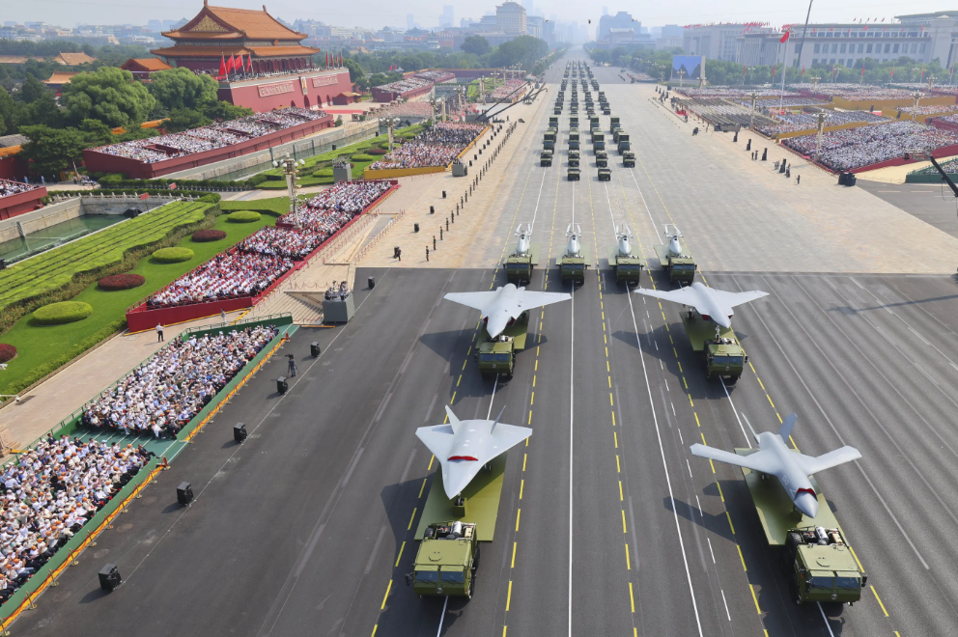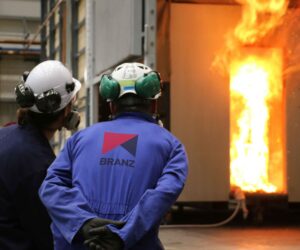The latest Chinese autonomous “Loyal Wingman” drones parade past the Presidential dias
Xinhua
China maintains a fairly established a rhythm of major military parades roughly every five years. The latest was staged yesterday in Beijing to mark the eightieth anniversary of Victory Day, marking the defeat of Imperial Japan in World War Two. The parade was a grand spectacle, but what was on display took it far beyond pageantry. The breadth of weapon systems showcased were both awe-inspiring and sobering. It underscored not only the scale of China’s modernization, but the degree to which autonomy and artificial intelligence have been integrated across the arsenal.
Many of the systems that participated in the parade were overtly autonomous. Many classes of loyal wingmen and reconnaissance drones rolled past, each embodying autonomy at every layer: flight control, mission planning, sensor interpretation, and even self-protection. Their presence confirms China’s pursuit of distributed air combat, where manned fighters like the new J-35 or the electronic warfare-equipped J-15DT will not fly alone but act as the node at the center of a cognitive swarm. I have written about this Chinese concept of operations previously. The J-15DT itself, along with its carrier-based attack and EW siblings, signaled the deepening of cognitive electronic warfare capabilities, where AI subsystems drive jamming, deception, and adaptive responses at machine speed.
Several headline systems stood out. The J-35 stealth fighter, in both naval and land-based configurations, flew for the first time in a state parade. It combines a low-observable airframe with a large internal weapons bay and avionics designed for sensor fusion. Analysts believe it is destined to operate from the Fujian carrier, forming the backbone of China’s next-generation carrier air wings. And clearly, production has begun because more airframes were revealed yesterday than were known to exist in the past. The aircraft is definitely in the LRIP, or low rate of initial production, phase. By next year, I expect serious numbers will begin to be produced.
Beside it in importance was the J-15DT, the electronic attack variant of the carrier-capable J-15 family. Outfitted with wingtip and underwing electronic warfare pods and operated by a crew of two, it is built to accompany strike packages into contested airspace. Its mission is to jam radars, blind missile batteries, and create corridors for follow-on forces. This is exactly the type of cognitive EW role that highlights the fusion of autonomy and AI with traditional air power. The United States Navy employs the venerable E/A-18G Growler in this role, but the J-15 platform is the most powerful EW aircraft in its class.
On the ground, the debut of the DF-61 intercontinental ballistic missile was a reminder and important signaling of the strategic dimension of China’s modernization. This new solid-fuel ICBM is assessed to carry multiple independently targetable reentry vehicles (MIRVs). Reports suggest each launcher may hold from ten to possibly 14 warheads, with maneuverable reentry vehicles designed to evade missile defense. The inclusion of this system alongside the JL-3 submarine-launched ballistic missile and the new air-launched Jinglei-1 ballistic missile completed, for the first time in public, China’s modernized nuclear triad. It is not far-fetched to assume that AI-based adaptive autonomy plays a role in the management, targeting, and decoying functions of these MIRVs/MARVs.
Equally striking was the array of counter-drone systems. China may be a world leader in developing drone systems. After all, it is home to the largest and most successful developer of small unmanned aerial systems, DJI. But developing the venom does not prevent China from also developing the antidote; counter UAS capabilities. The parade featured integrated gun-and-missile trucks armed with short-range interceptors, truck-mounted high-energy lasers resembling the export “Silent Hunter” class in the 30–100 kilowatt range, and high-power microwave emitters for swarm disruption. These systems are notable for their necessary reliance on AI vision and radar-fusion capabilities, enabling them to track, classify, and prioritize targets in dense airspace. A single ground vehicle equipped with dozens of short range missiles to be used against a swarm cannot possibly rely on human control. AI is the only game in town for this application.
And then there were the unmanned maritime systems. The AJX-002 undersea drone, or unmanned underwater vehicle, and a new stealth-profile uncrewed surface vessel appeared in convoy. Their mission profiles include covert minelaying, autonomous patrol, and decentralized, autonomous strike. There have also been references to the UUV’s capability to interdict undersea cables. In an environment where underwater communications are hazardous and may expose position, these vehicles must rely entirely on autonomy for navigation and mission execution. They are harbingers of an ocean battlefield increasingly populated by machines. As the numbers of such fleets become larger, what they can collectively achieve through distributed sensor deployments and AI-based sensor fusion, may surprise many.
Other capabilities were less obviously AI-infused, yet no less dependent on autonomy. Missiles, from the hypersonic DF-17 glide vehicle to the compact interceptors mounted on counter-drone trucks, rely on autonomous guidance, midcourse adaptation, and target recognition. Electronic warfare pods carried on every aerial platform make heavy use of AI for threat classification and cognitive jamming. Undersea drones must rely on autonomous navigation since continuous communications would betray their positions. Counter-drone systems combined miniaturized missiles, high-energy lasers, and directed microwave beams, fused together through AI-enabled vision and radar interpretation engines.
The new Chinese unmanned underwater vehicles participate in the 2025 Victory Day parade.
Xinhua
Western analysts who still find it difficult to contend with the reality of China’s exponential rise will point out that we cannot be certain many of the systems on parade were real. This is the new incarnation of an old refrain, once expressed as the claim that China simply copies everything. But the historical record speaks differently. In the past twenty-five years there have been five major parades, and only a very small number of systems showcased failed to make the transition into operational service. The WZ-2000 high-altitude reconnaissance drone from 2009 appears to have entered limited service, but was not fielded in great numbers. The ASN-229A strike UAV concept , likewise, appears to have disappeared after its parade debut. And some of the stealth UCAV mock-ups rolled out in 2019 did not materialize beyond the models displayed that day. These examples exist, but they are very rare. The overwhelming pattern is that what China showcases at Tiananmen becomes reality in squadrons, brigades, and fleets.
Yet, despite the integration of AI-driven control, reasoning, and perception into weapon systems, where AI may matter most is not in the systems themselves but in the capacity to build them. Many of the missiles, drones, and aircraft displayed in Beijing now emerge from highly automated factories. The PL-15, China’s very long-range beyond-visual-range air-to-air missile which entered service with the Pakistan Air Force, and was reportedly responsible for downing up to seven Indian aircraft in May, is not produced in artisanal workshops but in automated industrial facilities. These plants employ predictive maintenance, robotics, computer vision, logistics optimization, and advanced power management. China is weaving AI into every step of the production line. Thus, the PLA’s use of AI may not be confined to embedding machine intelligence into weapons, but to building the manufacturing infrastructure that underpins the industrial sinews of the cognitive era.
The Russo-Ukrainian war, and the Israel-Iran conflict have both shown that sophistication alone is meaningless if delivered in teaspoon doses. What China is fielding is scale. Any nation confronting Beijing will not face a handful of boutique drones or a symbolic squadron of stealth fighters. They will contend with millions of small unmanned aerial systems, hundreds of thousands of missiles and drones, and thousands of loyal wingmen operating in concert. These are non-trivial odds, and they redefine what modern military competition means in an AI-driven, Hyperwar era.









